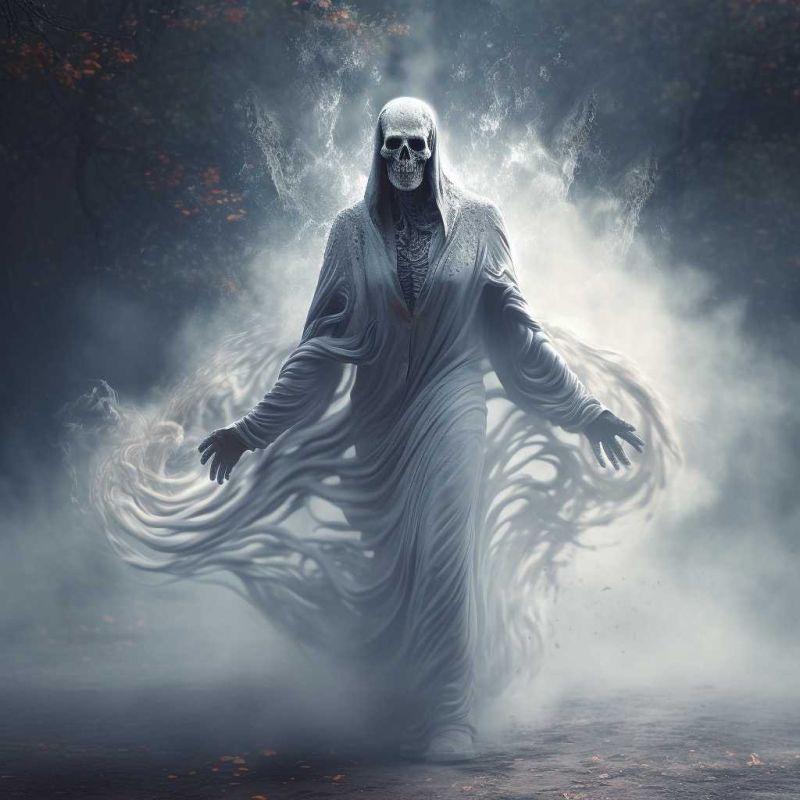 Natural Weapon(s):
Natural Weapon(s):-
Slam (d1)
 Passive Abilities:
Passive Abilities:-
Sunlight Sensitivity-1000 gp
 Attack Abilities:
Attack Abilities:-
Life Draining Strike (3d6)15000 gp
 Monster Bits:
Monster Bits:-
Ectoplasm5 gp
A pervasive chill envelops all. Rime crawls across surfaces, and your breath materializes in the frigid air. A distant, pained moan blends with the wind. In your peripheral vision, a figure detaches from shadows and glides toward you—weightless, formless, an undead specter, haunting the boundary between the corporeal and the ethereal with a sense of eerie inevitability.
👻🌑 Specters: Wrathful Shades of Stolen Souls
Specters are the anguished remnants of humanoids, their souls torn from life and denied passage to the afterlife. 🖤 Stripped of memories and identity, these unfettered spirits are condemned to an eternity of torment, haunting the Material Plane with a hatred that burns like cold fire. Born from dark magic, a wraith’s touch, or a cruel twist of fate, specters are spectral predators, their translucent forms gliding through shadowed places, driven to extinguish the life they can no longer claim. In any campaign, they are harbingers of despair, their relentless fury a chilling reminder of what awaits those who defy death’s natural order.
🕳️ Beyond Redemption: Doomed to Eternal Torment
Unlike ghosts, who may find peace by resolving their unfinished business, specters are beyond salvation. 🌪️ Their souls, severed from their past, are bound to the Material Plane with no hope of rest, their only release the final obliteration of their essence. They linger in forgotten ruins, desolate crypts, or cursed battlefields, carrying out a hollow existence that stretches across centuries. Their disconnection from who they were makes them pitiable, yet their unrelenting malice renders them deadly, a paradox of sorrow and savagery.
Game Masters can weave specters into their world as tragic relics—a village’s lost defenders, a mage’s failed experiment, or victims of a necromancer’s curse. Their lack of redemption offers narrative weight, forcing players to confront the cost of meddling with life and death.
⚔️ Undying Hatred: Scourge of the Living
The sight of living creatures ignites a specter’s soul with a maelstrom of sorrow and wrath, a painful reminder of the life they’ve lost. 😡 This hatred drives them to kill with merciless speed, their spectral claws draining vitality with a chilling touch. Each life they extinguish brings a fleeting flicker of satisfaction, but it is never enough—their anguish is a bottomless void, their rage an eternal flame. They strike without hesitation, their translucent forms weaving through defenses, untouchable by mundane weapons.
In combat, specters are relentless, their attacks fueled by raw emotion. Some may wail with psychic agony, stunning foes, or fade into shadows to ambush. GMs can enhance their threat with unique traits—a specter that leeches warmth, leaving frost on its victims, or one that mirrors its killer’s face in its final moments. Their hatred makes them unpredictable, a force players must outwit as much as outfight.
🌙 Dwellers in Darkness: Creatures of the Night
Specters recoil from sunlight, its radiant life a searing rebuke to their cursed existence. ☀️ By day, they retreat to the gloom of their haunts—crumbling cellars, shadowed forests, or sunken wrecks—where they brood in restless silence. When night falls, they emerge, gliding through the darkness to hunt the living, their glowing eyes piercing the gloom. Their immunity to most physical harm makes them bold, stalking prey with the confidence of predators who fear little in return.
GMs can use this nocturnal cycle to build tension, with specters stalking players under moonlit skies or ambushing them in darkened lairs. Their aversion to sunlight offers tactical opportunities—luring a specter into dawn’s light or wielding radiant magic to weaken its resolve. Placing their haunts in evocative locations, like a fog-choked graveyard or a cursed manor, amplifies their eerie menace.
🌌 Echoes of a Shattered Soul
Specters are more than monsters; they are fragments of tragedy, their hatred born from a theft of peace. 🖌️ In a campaign, they serve as chilling obstacles or sorrowful mysteries, their origins hinting at darker forces—a wraith’s rampage, a dark ritual gone awry, or a god’s wrath. Players might face a specter to reclaim a haunted relic, protect a village from nightly assaults, or uncover the truth behind its creation. Their lack of memory makes them enigmatic, their actions driven by instinct rather than reason, inviting GMs to craft haunting backstories that players can piece together.
In worlds like Zin, where ancient sins cast long shadows, specters might drift through war-torn ruins or cursed valleys, their wails echoing the land’s grief. To face a specter is to battle despair itself, a foe that offers no mercy and seeks no redemption. Heroes who destroy one may end its torment, but the specter’s fleeting scream lingers, a warning that some wounds in the soul never heal. 👁️🗨️
Environments:
![]()
![]()
👻💨 Apparitions: Spectral Heralds of Decay and Despair
Apparitions are vengeful spirits, tethered to the mortal realm by unresolved grievances and seething resentment. 🌫️ These spectral entities drift through the world, their translucent forms radiating an aura of rot and ruin that withers life and beckons the undead. Driven by unfinished business and fueled by rage, they are both a haunting tragedy and a deadly menace, their presence chilling the soul as surely as it blights the land. In any campaign, apparitions are poignant and perilous, their lingering emotions and decaying influence weaving tales of sorrow, vengeance, and redemption.
🕳️ Ethereal Form: Twisted Echoes of Life
Apparitions manifest as ghostly figures, their translucent bodies shimmering with an eerie, sickly glow. 🖤 Often, they resemble their living selves, but their forms are warped by resentment—eyes burning with malice, features contorted in anguish, or limbs trailing into wisps of shadow. A knight’s apparition might clutch a spectral blade, while a betrayed lover’s form drips with illusory tears. Their ethereal nature allows them to glide through walls and hover above the ground, untouchable by mundane weapons yet vulnerable to holy light or radiant magic that sears their corrupted essence.
Game Masters can tailor an apparition’s appearance to reflect its story—a merchant with coins spilling from spectral wounds, or a child clutching a broken toy. Their visual distinctiveness sets the tone for encounters, hinting at the emotions and events that bind them.
🌿 Signs of Decay: Blight of the Spectral Wake
Wherever an apparition lingers, the world sickens. 🌑 Plants wither to brittle husks, wood warps and rots, and the air turns cold and heavy with a stagnant, graveyard chill. This tangible aura of decay is unmistakable, marking their haunts with blackened earth or crumbling stone. The presence of an apparition draws undead—shambling zombies or wailing spirits—amplifying the danger of their domain, while living creatures suffer, their vitality sapped by the oppressive miasma.
GMs can use these signs to build dread, with players noticing wilting crops or rancid water as clues to an apparition’s influence. The decay can escalate with the apparition’s rage, turning a haunted manor into a rotting labyrinth or a village into a necrotic wasteland, creating dynamic environments for exploration or combat.
🗝️ Unfinished Business: Anchors of the Soul
Apparitions are bound by unresolved tasks from their lives, their spectral existence a desperate bid to complete what death denied them. ⚖️ A warrior might seek vengeance for a betrayal, haunting their killer’s lineage; a guardian might protect a lost treasure, unable to rest until it’s safe; a parent might linger to fulfill a broken promise to a child. These goals drive their actions, and resolving them—through aid, trickery, or force—can lay an apparition to rest, freeing its soul from torment.
Understanding an apparition’s purpose is key to confronting it. Some can be reasoned with, their rage soothed by fulfilling their desires, while others are too consumed by hatred to negotiate. GMs can craft unique tasks tied to the campaign’s lore—a forgotten oath to a fallen god, or a love letter never delivered—making each apparition a narrative puzzle that rewards empathy or cunning.
⚔️ Resentment and Rage: Fury of the Forsaken
An apparition’s heart burns with intense emotions—grief, betrayal, or unquenched wrath—that fuel its spectral might. 😡 In combat, they unleash this rage, hurling necrotic blasts, draining life with a chilling touch, or summoning decayed remnants of their past to fight. Their ethereal forms shrug off physical blows and necrotic forces, but holy relics, radiant spells, or artifacts tied to their life—like a betrayer’s dagger or a lover’s locket—can pierce their defenses, unraveling their essence.
Their emotions also shape their behavior. A sorrowful apparition might plead for aid, while a vengeful one hunts relentlessly. Players who discern these feelings—through investigation or magic—can turn the tide, calming the spirit with empathy or provoking it to reckless fury. GMs can use this emotional core to create dynamic encounters, where combat blends with roleplay, and understanding the apparition’s pain becomes as crucial as striking it down.
🌌 Shadows of a Shattered Past
Apparitions are more than spectral foes; they are echoes of lives left incomplete, their decay a mirror to their inner torment. 🖌️ In a campaign, they serve as haunting mysteries, their haunts revealing forgotten sins or buried truths. Players might aid an apparition to free a cursed village, battle one to claim its guarded relic, or uncover its story to prevent a greater evil. Their origins can anchor to any setting—a scorned priest in a desecrated temple, a sailor lost to a storm-haunted reef, or a rebel executed in a tyrant’s dungeon—offering GMs endless ways to enrich their world.
In realms like Zin, where ancient grudges linger, apparitions might drift through war-scarred ruins, their rot seeping into the land’s wounds. To face an apparition is to grapple with the past’s weight, a challenge that tests compassion as much as courage. Heroes who resolve an apparition’s pain may bring peace to a haunted place, but those who falter risk falling to the decay that follows in its wake, forever marked by the specter’s wrath. 👁️🗨️
 Special Senses:
Special Senses:-
 Nightsight: +60
Nightsight: +60
-
 Ghostsight: +60
Ghostsight: +60
 Damage Type Immunity:
Damage Type Immunity:-
 Cold
Cold -
 Necrotic
Necrotic
 Damage Type Vulnerability:
Damage Type Vulnerability:-
 Radiant
Radiant
 Immune to Status Effect:
Immune to Status Effect:-
 Bleeding (2d6)
Bleeding (2d6) -
 Charmed
Charmed -
 Chilled
Chilled -
 Freezing
Freezing -
 Frightened
Frightened -
 Frozen
Frozen -
 Grappled
Grappled -
 Grappling
Grappling -
 Immobile
Immobile -
 Paralyzed
Paralyzed -
 Petrified
Petrified -
 Prone
Prone -
 Restrained
Restrained -
 Sleeping
Sleeping -
 Starving
Starving -
 Suffocating
Suffocating
 Persistant/Permanent Status Effect:
Persistant/Permanent Status Effect:-
 Incorporeal
Incorporeal
-
 Damage Mitigation:
+2
Damage Mitigation:
+2
